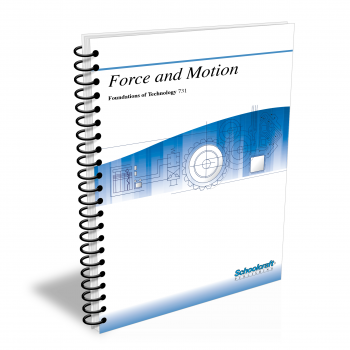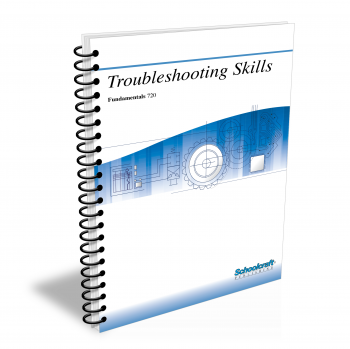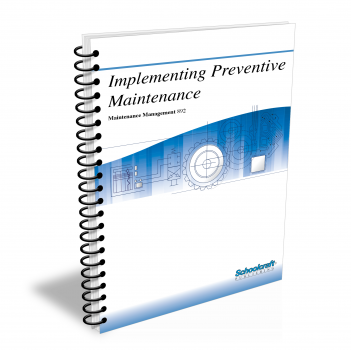Force and Motion

Course Number: 731
The first eight lessons in the Force and Motion textbook deal with the basic concepts of force and motion. The presentation is simple and straightforward, but precise. Students will learn to think about familiar examples of force and motion in a very logical and methodical manner. After learning to use vectors to describe both forces and motion, they will combine the two through the use of Newton's second law. These concepts will then carry over to rotational motion and simple harmonic motion. The textbook concludes with two lessons describing basic mechanical components.
Does your curriculum require additional topics not included in this textbook? Build a customized version of the Force and Motion textbook below.
Recommended Contact Hours – 15
Preview a Chapter
Available Supporting Material
- Table of Contents
- Exam Copies
- Suggested Titles
Table of Contents
Chapter 1: Scalars and Vectors
Topics: Physical quantities; Properties and components of vectors; Adding, subtracting, multiplying, and dividing vectors
Learning Objectives:
- Explain the difference between scalars and vectors, and list examples of each.
- Draw a vector, given a verbal description.
- Describe a vector verbally, given its graphic symbol, a frame of reference, and an appropriate scale.
- Define resolution, resultant, and commutative.
- Demonstrate how to resolve a vector into its rectangular components.
- Demonstrate how to add and subtract vector quantities in one-dimensional and two-dimensional frames of reference.
- Multiply and divide a vector by a scalar.
Chapter 2: Motion Along a Straight Line
Topics: Speed; Velocity; Slope; Changing and instantaneous velocity; Velocity-vs-time graph; Finding displacement; Using a curved graph
Learning Objectives:
- Explain the difference between speed and velocity.
- Define the terms instantaneous velocity, average velocity, and slope.
- Identify the delta notation, and explain how to use it in a calculation.
- Demonstrate how to determine displacement and velocity from a position-versus-time graph.
- Demonstrate how to determine displacement by calculating the area under a velocity-versus-time graph.
Chapter 3: Acceleration
Topics: Directional acceleration; Equations of motion; Acceleration due to gravity; Upward and lateral motion during free fall
Learning Objectives:
- Define acceleration.
- Demonstrate how to determine the magnitude of an acceleration from a velocity-verses-time graph.
- Demonstrate the difference between average acceleration and instantaneous acceleration.
- Solve simple problems for average acceleration, displacement, and final velocity.
- Explain why the velocity-verses-time graph for all objects in free fall are parallel (when drawn on the same coordinate system).
Chapter 4: Describing Forces
Topics: Motion; Basic forces of nature; Action/reaction pairs; Newton's Third Law of Motion; Unbalanced forces; Resolution of forces
Learning Objectives:
- Define force.
- Name the four basic types of forces in nature.
- State Newton's Universal Law of Gravitation.
- Explain how and why vectors are used to represent forces.
- Explain Newton's Third Law of Motion.
- Give examples which demonstrate that forces always occur in action-reaction pairs.
- Demonstrate how to add force vectors.
- Describe how to resolve a force vector into its components.
Chapter 5: Force and Acceleration
Topics: Friction; Newton's First and Second Laws of Motion; "Resistance" to acceleration; Units of force; Conservation of momentum
Learning Objectives:
- State Newton's First Law of Motion.
- Define inertia, and describe how it is measured.
- Explain why a force must be applied continuously to objects on earth in order to maintain their motion.
- Explain what happens when a net applied force is greater than the friction force.
- State Newton's Second Law of Motion.
- Solve problems using the equation F=ma.
Chapter 6: Equilibrium
Topics: Forces on bodies; Particles in static equilibrium; Equilibrium of a rigid body; Center of mass
Learning Objectives:
- State the two conditions of equilibrium, and distinguish between static and dynamic equilibrium.
- Explain the difference between particles and rigid bodies.
- Define torque.
- Solve problems involving torque and rotational equilibrium.
Chapter 7: Rotational Motion
Topics: Centripetal and centrifugal force; Rotational motion; Angular displacement; Velocity; Acceleration; Tangential acceleration; Moments of inertia
Learning Objectives:
- Describe centripetal force.
- Differentiate between centripetal acceleration, angular acceleration, and tangential acceleration, and state the formula for each.
- Demonstrate how to convert degree measurements to radian measurements.
- Define the terms uniform circular motion, period angular velocity, angular impulse, angular momentum, and moment of inertia.
- Explain why moment of inertia is calculated differently for different objects.
- State Newton;s Second Law in terms of rotational motion.
- Identify examples of the Law of Conservation of Angular Momentum.
Chapter 8: Simple Harmonic Motion
Topics: Periodic motion; Simple harmonic motion; Hooke's Law; Equations of harmony; Resonance
Learning Objectives:
- Describe the relationship between simple harmonic motion and uniform circular motion.
- Define the terms cycle, amplitude, frequency, period, and Hertz.
- State Hooke's Law.
- Describe how acceleration and restoring force vectors change as an object moves in simple harmonic motion.
- Use equations to determine the period and frequency of both a mass-spring system and a pendulum.
- Give examples of resonance.
Chapter 9: Machine Elements
Topics: Machine motions; Mechanisms; Lever and four-bar linkages; Devices for producing linear motion; Ratchet-and-pawl and fluid-power mechanisms
Learning Objectives:
- List the four classifications of mechanisms.
- Name the six basic motion conversions, and give an example of each.
- Explain the functions of bell cranks, Pitman arms, and toggle bars.
- Name three types of four-bar linkages, and explain how they function.
- Describe the ratchet-and-pawl mechanism.
Chapter 10: Fasteners
Topics: Threaded fasteners; Screw threads; Types of nuts; Washers; Safety wiring; Keys and pins; Rivets
Learning Objectives:
- Identify seven major types of threaded fasteners.
- Read and interpret common screw thread and threaded fastener specifications.
- Describe the three actions in a manual riveting operation, and explain why each action must be done properly.
- Demonstrate the proper technique for safety wiring a group of threaded fasteners.
- Identify three kinds of washers.
Request Exam Copies
Exam Copies
Ready to see a copy of our textbooks? After selecting which textbooks you’d like to review for your course, you can submit your request by either logging in or creating an account so we know where to ship your exam copies. A representative from Schoolcraft will contact you to confirm and finish processing your request.
Exam copies are always free and yours to keep.
Selected Exam Copies
none selected
* Maximum of five copies can be ordered


